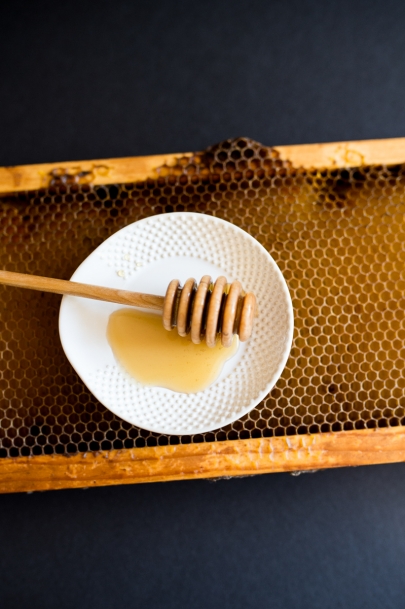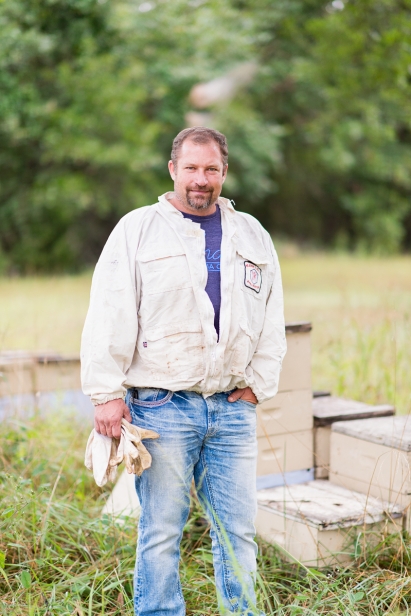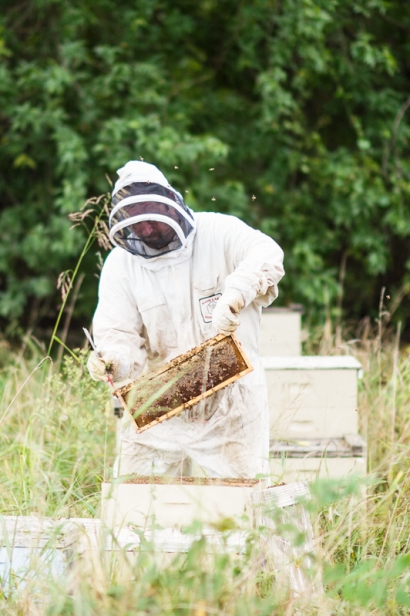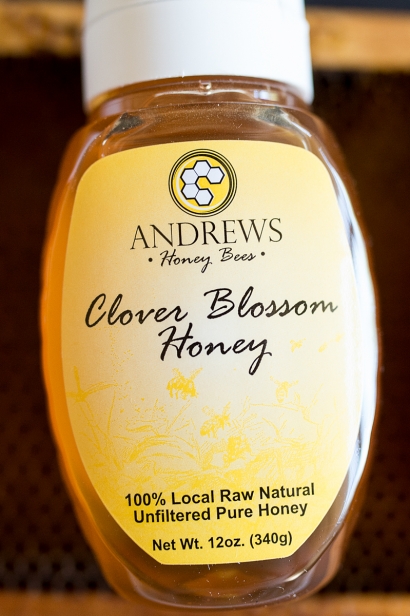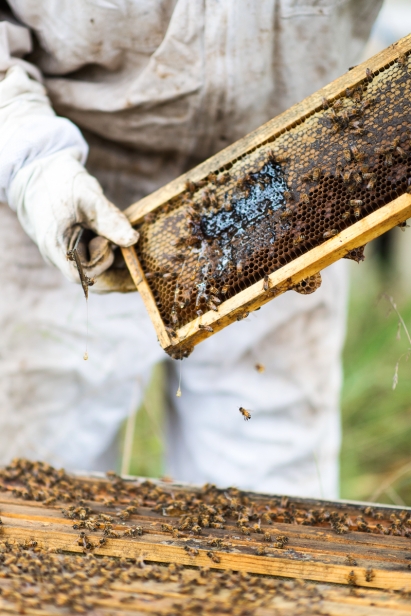Andrews Honey Bees
Learning about beekeeping and photographing a hive have always been on my bucket list. And let’s be honest, I thought wearing a bee suit would be cool. Well, actually, it was smoldering inside the bee suit in the Oklahoma August heat, but nonetheless, engaging with the process of natural honey production was a gratifying experience. I will say that I had quite the romanticized view of what it takes to keep bees. In my mind, it was a calm and dainty experience, but I found out about the real nitty gritty. Extraordinary balance is required to care for the bees, gather the honey, and handle bee stings from our buzzing buddies who seem not to appreciate the intrusion! I certainly walked away from the hives with a new respect for Kevin, who earned fifteen stings just during our shoot, and the other brave people who watch over honey bees.
Company Name: Andrews Honey Bees
Name: Kevin Andrews
Website: andrewshoneybees.com
Tell us a little bit about your company:
We offer pure, raw, unfiltered, hive-to-bottle honey!
Why did you decide to go into beekeeping?
I bought a hobbyist bee kit for my son’s birthday and you know how kids are, it went in the closet for a couple of years. One day we were cleaning out the closet and decided to go for it. We were not immediately successful. We accidently killed off our first hive. But as we learned more about agriculture and the nature of bees we slowly became successful. One hive grew to two hives, so on and so on and before we knew it, it was more than a hobby. From that point, we began to meet people in the bee farming industry. A buddy of mine got us into bee pollination and told us about the need Oklahoma farmers had for bee farmers to pollinate their fields. So we uprooted from California and made our way to Oklahoma for bee pollination.
Can you walk us through the process of honey production from bee to bottling?
We plant hives in certain locations across Oklahoma where there’s a particular selection of flora. After the bees collect nectar from that field, we extract the honey and separate it into different barrels, depending on the blend of nectar flavor. Then, after we extract the honey, we barrel it and store it until it’s ready to be bottled. Our honey is hive-to-bottle prepared, which means it’s so pure that in a couple of months, depending on the moisture of the season, it will return to crystallization. So we bottle it as it’s ordered.
What type of honey products do you offer?
Andrews Honey Bees is known for carrying a variety of honey flavors: Clover Blossom, Wildflower Blossom, Orange Blossom, Alfalfa Blossom, Cream, and Cinnamon Cream honey. We are widely recognized for our Cinnamon Cream Honey. This is the only honey we add anything to, and it’s simply cinnamon. It’s a magical tasting experience.
Why is local honey better?
Pure, raw, unfiltered honey protects the integrity of keeping particles of pollen, propolis, and beeswax in the honey. This is the integrity we seek to provide in every honey we bottle. This type of honey offers amazing medicinal properties. We have hives planted all over Oklahoma, so clearly, we never want to discourage from buying honey as local as possible. But we get this question a lot and there is some very misleading, almost wacky information circling the honey connoisseur community.
Does the honey change from season to season?
Definitely! Every flower secretes a different type of nectar. Honey is a lot like wine. The soil, the region, the climate, & the moisture play a huge role in what the honey bees produce. Also, because of climate and moisture, the nectar flowers will vary year to year. This will greatly affect the color, texture, and taste of the honey. For example, our Wildflower Blossom will change, not only season to season but from hive to hive. This is why batches will vary in color and thickness. Also, this is why Clover Blossom honey is the most preferred taste in honey. Clover is more predictable in color, texture, and taste.
What are some uses for honey that we might not be as familiar with?
Honey isn’t just good for the inside of the body, but also the out. Cleopatra attributed her everlasting beauty to milk and honey baths. Crystallized honey makes a great skin exfoliate. Honey and beeswax are amazing for topical wounds. Honey is antibacterial, so it does wonders for skin acne.
What are some of the challenges that come along with beekeeping?
There are four main challenges: location, genetically modified plantation, pesticides, and Varroa mites.
First, the lack of locations that offer good nectar supply is a big challenge. People cut down wonderful wildflowers and weeds that bees gather from and therefore it limits nectar supply. When the state can’t mow down the side of the roads, that is actually a benefit to the bees. There’s so much clover growing on the side of the road that would be perfect collection for bees, but we mow it down. We resort to planting hives along riverbeds because this is the most untouched terrain in Oklahoma.
The second is changing the genetics in plants. One example is soybeans. We’ve taken out the nectar flow to be able to manually produce a larger bean.
The third is pesticides. Pesticides on a large farming scale are taking their toll, sure, but also the personal at home use. We love luscious, green lawns that contain no weeds. In the process of obtaining that, individuals use pesticides that end up killing off what bees would naturally forage. It’s hard to get into this topic because globally pesticides are affecting our planet to degrees we may never be able to reverse.
The third is Varroa mites. They sneak into a hive and infect the hive with viruses. When one hive gets infected, it runs the risk of ALL hives becoming infected. The viruses the mite leaves affect the DNA of bees so when they reproduce, new bees are deformed and unable to work. Currently, there is no solution for this Varroa mite. When they are found, oftentimes beekeepers have to burn their frames and start fresh.
How many bees live in a hive?
It just depends on the season. In the summer, a hive can be 50,000 to 80,000.
What can we do to help promote the bee population?
Don’t kill beehives. No matter what. Before exterminating them, try to have them relocated. Don’t be afraid to let the wildflowers grow. We are so committed to growing the bee population. For 2017, we are planting ten wild hives across the state. We will maintain the hives to check for Varroa mites and hive beetles, but other than that, we will not farm these hives. These hives will be able to flourish in their natural habitat.
Anything exciting in the near future for Andrews Honey Bees?
We are so blessed to have a loyal Andrews Honey Bees fan community. And because of this, we have been able to expand to most local retailers across the state. We are so thankful Oklahomans are passionate about the wellness of the bees and being committed to pure, raw honey. We love it. We appreciate it. This passion is what keeps us committed to our brand integrity.
Where can we find Andrews Honey Bees products?
We can be found at local independent retailers throughout the state like Urban Agrarian. In fact, we owe so much of our brand expansion to Urban Agrarian; they have been with us from the beginning. Excitedly though, we can also be found at Crest and Natural Grocers.
Do you have any good holiday recipes that we could include honey in?
Oh, man. We suggest substituting our honey for cane sugar in any recipe. Start with a simple cookie recipe. Or if you aren’t great at baking, find a piece of bacon, smother with Cinnamon Cream honey, eat, and bacon will never be the same.
Thank you, Kevin!


